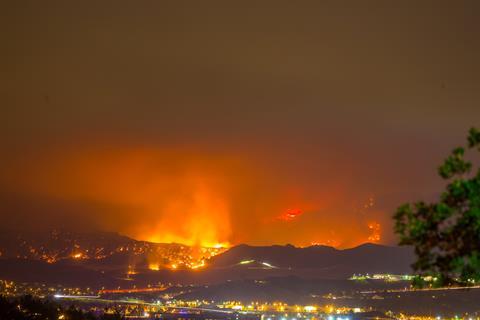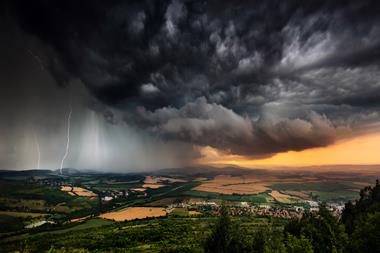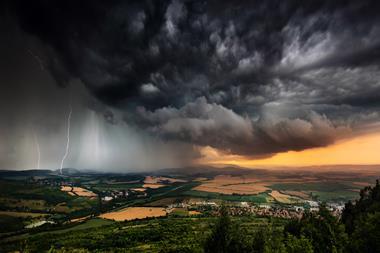Wildfires in California alone contributed about $38bn of insured losses, or 71% of the total, according to the re/insurance broker.
Aon has reported record-breaking economic losses of $83bn from global natural disasters in the first quarter of 2025, driven largely by California wildfires and a series of billion-dollar events across the United States.

The figure is significantly above the 21st century Q1 average of $61bn and up from $54bn in the same period last year.
According to the broker’s Q1 Global Catastrophe Recap – April 2025, US disasters accounted for $71bn of the total, the country’s highest first-quarter loss since 1994 and far above its long-term Q1 average of $12bn.
In contrast, economic losses across all other global regions came in below their respective quarterly averages.
Wildfires in California alone contributed about $38bn of insured losses, or 71% of the total.
Globally, insurers are expected to cover more than $53bn of the total catastrophe bill – making it the second-highest Q1 insured loss on record after 2011 and well above the 21st century Q1 average of $17bn.
Aon estimated the Q1 insurance protection gap at 36% – the lowest for the first quarter since 1990 – reflecting high coverage levels in the US.
Fatalities from disasters surged to more than 6,000 in the quarter, up from 1,800 a year earlier.
Around 88% of those deaths were attributed to the March earthquake in Myanmar. Other events accounted for roughly 700 fatalities combined.
The report also noted that global disaster losses in 2024 reached $374bn, inflated to 2025 dollars, marking the ninth consecutive year above the $300bn threshold.
With severe convective storm (SCS) insured losses in the US averaging $33bn a year since 2015 – a 90% increase on the previous decade – Aon has introduced a new five-step framework to help insurers manage the risk and reduce volatility.
What risk managers need to know
Aon’s 2025 climate catastrophe insight report said that risk management is key as weather patterns increase the severity of natural catastrophes.
Physical damage impacts businesses, lives and livelihoods, highlighting the need for better adaptation strategies. The insurance industry plays a critical role by providing capital to reduce risk and increase resilience.
Businesses must therefore:
- Understand the impact of climate risk to buildings and people to build more resilient infrastructures and workforces.
- Ensure natural perils and climate are evaluated and managed with the same rigor as other risk exposures, using tools and analytics to support decision making.
- Evaluate the current and future impacts of climate risks on the workforce across key indicators, including productivity, healthcare costs and talent supply to adapt to change and help manage risk.
- Develop robust disaster recovery plans and support services with just-in-time employee relief.
- Proactively prepare to help employees understand potential risks, avoid uncertainty and improve communication during an event.
Michal Lörinc, head of catastrophe insight at Aon, said: “The economic uncertainty presented by natural catastrophes, such as the devastating wildfires in California and the deadly earthquakes in Myanmar, underscores the critical need for comprehensive risk management strategies.
The role of weather forecasts
The report found that weather forecasting plays a crucial role in mitigating losses from natural disasters by providing timely and accurate information that can help in preparation and response efforts.
This results in enhanced early warning systems, effective pre-event planning, resource allocation, and improved risk assessment, all to lessen economic impacts and ensure public safety.
It highlighted that current and future weather forecasting may profit from new AI-based models that have been developed in recent years. These are designed to complement traditional numerical weather prediction models.
The report adds that strengthening supply chains is essential to mitigate the impact of nat cat on trade.
Natural disasters disrupt trade by halting production, impeding transportation and losing sales. This can cause economic, operational and reputational damage, as well as a loss of market share and competitiveness.
Risk management solutions include parametric insurance to provide support around non-physical damage with triggers around loss of sales or spikes in temperature.
Businesses can protect supply chains by:
- Adapting to the changing climate with new forms of capital, such as parametric, to avoid loss of market share and competitiveness.
- Investing in renewable energy, diversifying supply chains, improving transparency and traceability and accessing new sources of capital to protect business interests.
- Integrating advanced analytics, Internet of Things (IoT), and AI into supply chain management, enhancing real-time monitoring and predictive capabilities to mitigate risks.
- Climate-proofing supply chains to help providers offer incentives, such as premium discounts and more favourable terms.














No comments yet